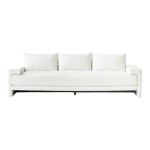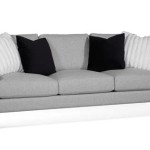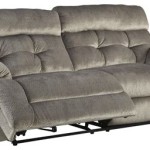How to Decorate a Dark Grey Sofa: A Comprehensive Guide
A dark grey sofa serves as a versatile and sophisticated foundation for any living space. Its neutrality allows it to integrate seamlessly with a variety of color palettes and design styles, from minimalist modern to cozy traditional. However, the very quality that makes it so adaptable – its darkness – can also pose a decorating challenge. Without careful consideration, a dark grey sofa can visually absorb light and make a room feel smaller or even gloomy. This article provides a comprehensive guide to effectively decorate around a dark grey sofa, ensuring it becomes a focal point of the room while maintaining a bright, inviting atmosphere.
Understanding the Undertones of Your Grey Sofa
The first step in decorating around a dark grey sofa is to identify its undertones. Grey isn't just grey; it can lean towards warm or cool, possessing subtle hints of blue, green, brown, or purple. Determining the undertone is crucial for selecting complementary colors and accessories. A sofa with cool undertones pairs well with blues, greens, and purples, while a sofa with warm undertones complements earth tones, reds, and yellows.
To identify the undertones, compare the sofa to a pure white sheet of paper in natural light. The colors that appear to be reflected or enhanced in the grey fabric will indicate its undertones. For example, if the grey appears slightly bluish or greenish compared to the white paper, it likely has cool undertones. Conversely, if it appears slightly brownish or yellowish, it likely has warm undertones.
Once the undertones are identified, the selection of complementary colors becomes significantly easier. Using colors that clash with the undertones can result in a visually jarring and unpleasant effect. Sticking to colors that harmonize with the undertones ensures a cohesive and balanced aesthetic.
Layering Textiles: Pillows, Throws, and Rugs
Textiles are essential for adding texture, color, and visual interest to a space featuring a dark grey sofa. Pillows and throws offer opportunities to introduce patterns, textures, and pops of color that break up the monotony of the dark grey and contribute to overall comfort and style. The careful selection of a rug also plays a crucial role in anchoring the seating area and creating a sense of cohesion.
When selecting pillows, consider a mix of sizes, shapes, and textures. Combining square, rectangular, and round pillows in varying fabrics like velvet, linen, and faux fur will add depth and sophistication. Introduce patterns cautiously, ensuring they complement the overall color scheme and style of the room. Geometric patterns, floral prints, and abstract designs can all work well, depending on the desired aesthetic.
Throws provide an additional layer of warmth and visual interest. Drape a throw casually over the back or arm of the sofa to add a touch of coziness. Choose a throw in a complementary color or texture that contrasts with the sofa fabric. Chunky knit throws, faux fur throws, and lightweight linen throws can all create different effects.
The rug serves as the foundation of the seating area. Choose a rug that is large enough to ground the sofa and other furniture in the space. The color and pattern of the rug should complement the sofa and other textiles in the room. A light-colored rug can help to brighten the space and create a sense of openness, while a patterned rug can add visual interest and personality.
Lighting Strategies: Maximizing Brightness and Creating Ambiance
Proper lighting is critical for mitigating the potential darkness of a dark grey sofa and creating a welcoming atmosphere. Layered lighting, combining ambient, task, and accent lighting, is the most effective approach. This strategy ensures adequate illumination while also allowing for the creation of different moods and atmospheres.
Ambient lighting provides overall illumination for the room. This can include overhead lighting, such as chandeliers or recessed lights, as well as floor lamps and table lamps. Choose light fixtures that emit a warm, inviting glow to counteract the coolness of the dark grey sofa. Avoid harsh, bright white light, which can feel sterile and unwelcoming.
Task lighting provides focused illumination for specific activities, such as reading or working. Place table lamps next to the sofa for reading, or use a floor lamp to illuminate a particular area of the room. Adjustable task lighting allows for customized illumination and increased functionality.
Accent lighting highlights specific features of the room, such as artwork or architectural details. Use spotlights or track lighting to draw attention to these elements and create visual interest. Accent lighting can also be used to add drama and depth to the space.
In addition to the type of lighting, consider the color temperature of the light bulbs. Warmer color temperatures, such as 2700K to 3000K, create a cozy and inviting atmosphere, while cooler color temperatures, such as 4000K to 5000K, provide brighter and more focused illumination. For a living room with a dark grey sofa, warmer color temperatures are generally preferred.
Wall Color and Art Selection: Creating Visual Harmony
The color of the walls surrounding a dark grey sofa significantly impacts the overall look and feel of the room. Light and airy wall colors can help to brighten the space and balance the darkness of the sofa. Conversely, darker wall colors can create a more dramatic and intimate atmosphere. The selection of artwork also plays a critical role in complementing the sofa and adding personality to the space.
For a bright and airy feel, consider painting the walls in light neutrals such as white, off-white, cream, or light grey. These colors reflect light and create a sense of spaciousness. Pastel colors, such as light blue, green, or lavender, can also work well, adding a touch of color without overwhelming the space.
If a more dramatic and intimate atmosphere is desired, consider painting the walls in darker colors such as navy blue, charcoal grey, or deep green. These colors can create a cozy and sophisticated feel. However, it is important to ensure that the room has adequate lighting to prevent it from feeling too dark and gloomy.
The artwork should complement the sofa and the overall color scheme of the room. Choose pieces that incorporate colors and patterns that harmonize with the sofa and other textiles in the space. Consider the size and scale of the artwork in relation to the sofa and the wall. A large piece of artwork can serve as a focal point, while smaller pieces can be grouped together to create a gallery wall.
When selecting frames for artwork, consider the style of the room and the colors of the artwork. Simple, minimalist frames can work well in modern spaces, while more ornate frames can add a touch of elegance to traditional spaces. Choose frame colors that complement the artwork and the wall color.
Adding Natural Elements: Plants and Wood Tones
Incorporating natural elements, such as plants and wood tones, can add warmth, texture, and life to a space featuring a dark grey sofa. Plants bring a touch of the outdoors inside, adding color and visual interest. Wood tones warm up the space and create a sense of connection to nature.
Select plants that thrive in the lighting conditions of the room. Low-light plants, such as snake plants, ZZ plants, and peace lilies, are ideal for spaces with limited natural light. Plants with larger leaves can create a dramatic effect, while smaller plants can add a touch of whimsy.
Use planters that complement the style of the room. Ceramic planters, terracotta pots, and woven baskets can all add texture and visual interest. Consider grouping plants together to create a focal point or placing them strategically throughout the room to add touches of greenery.
Wood tones can be incorporated through furniture, accessories, and flooring. Wood coffee tables, side tables, and shelving units can add warmth and texture to the space. Consider using wooden picture frames, bowls, and other decorative objects to tie the look together.
The type of wood used can also impact the overall look and feel of the room. Light-colored woods, such as birch and maple, create a bright and airy feel, while darker woods, such as walnut and mahogany, add warmth and sophistication. Choose wood tones that complement the sofa and other elements in the room.
Ultimately, successfully decorating around a dark grey sofa involves a thoughtful consideration of color, texture, lighting, and the incorporation of natural elements. By understanding the undertones of the sofa and employing strategic decorating techniques, one can create a space that is both visually appealing and comfortable. The key is to balance the darkness of the sofa with lighter elements, ensuring a bright, inviting, and harmonious environment.

Grey Couch Living Room Ideas For Your Home Designcafe

34 Stylish Dark Grey Couch Living Room Ideas And Brown

4 Ways To Decorate Around Your Charcoal Sofa Maria Killam

10 Best Dark Gray Sofas You Can Living Room Scandinavian Apartment Design
5 Grey Living Room Ideas Dfs

20 Grey Couch Living Room Ideas For A Neutral Timeless Appearance Coco Lapine Designcoco Design

Grey Sofa For Living Room Design Ideas Designcafe

4 Ways To Decorate Around Your Charcoal Sofa Maria Killam

Grey Couch Living Room Ideas Organic Dark

14 Ways To Style A Grey Sofa In Your Home Smart Furniture Decor








